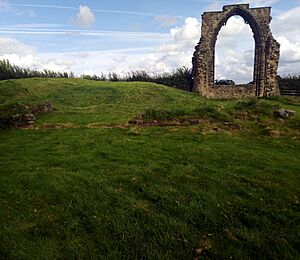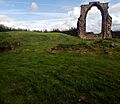Scheduled monuments in the Borough of Erewash facts for kids
This is a list of scheduled monuments in the borough of Erewash in the English county of Derbyshire. These are special places that tell us about history!
In the United Kingdom, a scheduled monument is a "nationally important" archaeological site or historic building. Think of them as super important historical spots that need extra care. They are protected by law to make sure they don't get changed without permission. The Secretary of State for Culture, Media and Sport puts them on a special list, and English Heritage helps find these sites.
There are about 20,000 scheduled monuments in the UK. English Heritage keeps this list updated. Sometimes, more than one historical spot can be part of a single entry on the list.
Derbyshire has over 500 scheduled monuments! These include old stone piles called cairns, stone circles, ancient burial mounds (barrows), remains from lead mining, old settlements, and more than 20 bridges.
What are Scheduled Monuments?
A scheduled monument is a very important historical place or building that is protected by law. This protection means that no one can change or damage it without special permission. These sites are chosen because they are important for understanding the history of the country.
Why are These Sites Protected?
These sites are protected to make sure they last for a long time. They help us learn about how people lived in the past, what they built, and what their lives were like. Without protection, these valuable historical clues could be lost forever.
Scheduled Monuments vs. Listed Buildings
Sometimes, a scheduled monument can also be a listed building. Both are protected, but in slightly different ways. English Heritage usually thinks that being a listed building is a better way to protect buildings. If a monument is no longer considered important enough, it can be removed from the scheduled list.
Amazing Monuments in Erewash
Erewash is home to several fascinating scheduled monuments. Each one tells a unique story about the past.
Dale Abbey
Dale Abbey is the remains of an old abbey. An abbey is a type of monastery where monks or nuns lived and worshipped. The Augustinian canons, who were a type of religious group, moved to Dale Abbey in 1162. Before that, they lived at Calke Abbey.
Today, you can still see parts of the abbey, including a tall window that is about 40 feet high. Digging at the site has shown that the church used to have long arms (called transepts) that were 100 feet long. It also had a tower in the middle, a square courtyard (cloister) that was 85 feet wide, and a long main hall (nave) of unknown length.
Hermitage at Dale Abbey
Near Dale Abbey, you can find a special cave known as the Hermitage. This is a hermit's cave, which means it was a simple home cut right into the rock. It's believed that a baker from Derby created this cave in the 12th century. It's located about 170 meters southeast of All Saints Church.
Lock Up and Pinfold in Sandiacre
In Sandiacre, there's a scheduled monument that includes a "lock up" and a "pinfold." A lock up was a small, temporary jail where people who broke minor laws were held. A pinfold was an enclosure used to keep stray animals, like sheep or cattle, until their owners claimed them. These structures show how communities managed law and order and livestock in the past.
Medieval Iron Working Remains
At Stanley monastic grange, there are remains from medieval iron working. A grange was a farm belonging to a monastery. This site shows us how people in the Middle Ages made and worked with iron. This was a very important skill for making tools, weapons, and other useful items.
Moated Site and Fishponds
At Moat Wood in West Hallam, you can find a moated site with two fishponds. A moated site is where a building, often a house, was surrounded by a ditch filled with water for protection. The fishponds would have been used to raise fish for food, which was common in medieval times.
Motte South West of Morley House Farm
Near Morley House Farm in Morley, there is a "motte." A motte is a large mound of earth that was part of an early type of castle, often built by Normans. A wooden or stone tower would have stood on top of the motte, giving a good view and a strong defensive position.
Roman Fort in Sawley
In Sawley, there are remains of a Roman fort. A fort was a military base built by the Roman army. This fort is located about 180 meters east of All Saints' Church. Roman forts were important for controlling areas and protecting Roman soldiers and settlements.
Images for kids





